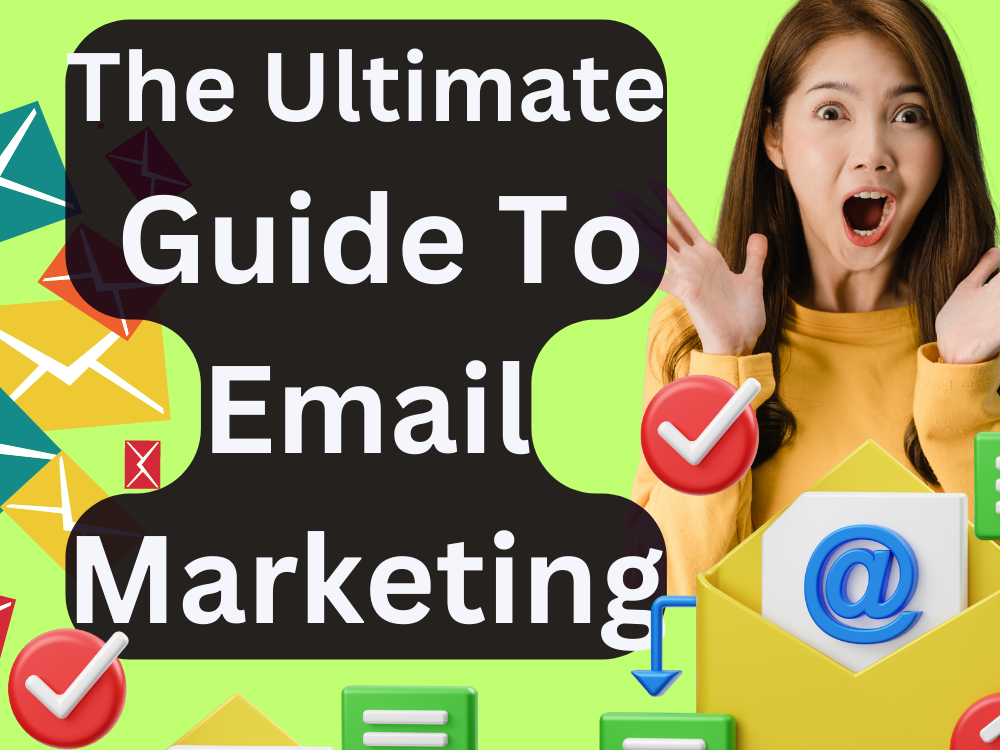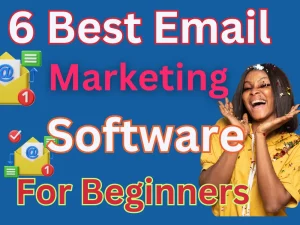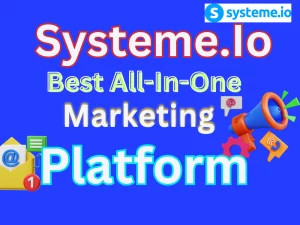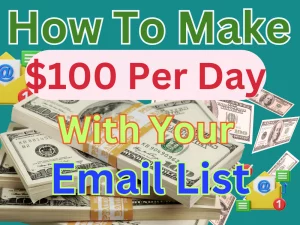Email marketing is a powerful tool that can be used to reach a large audience, promote products or services, and grow a business. In this blog post, titled “The Ultimate Guide to Email Marketing” I will discuss everything you need to know about email marketing, from getting started to creating effective campaigns.
Let’s start by defining the meaning of email marketing!
Table of Contents
What is Email Marketing?

Email marketing is a form of direct marketing that uses email to promote products or services to a targeted audience. It is one of the most effective and popular marketing channels available.
Email marketing can be used to achieve a variety of marketing goals, such as:
- Increasing brand awareness
- Generating leads
- Driving sales
- Providing customer service
- Nurturing relationships with customers
To be successful, your email marketing campaigns must be well-targeted, personalized, and relevant to the recipient. As an email marketer, you must also do your best to follow strict spam laws to avoid getting your emails marked as spam.
The Ultimate Guide to Email Marketing is a comprehensive guide that will teach you everything you need to know about email marketing, from creating an email list to writing effective email copy to tracking your results.
If you’re looking to learn more about email marketing, or if you’re looking to create effective email marketing campaigns, then The Ultimate Guide to Email Marketing is the perfect resource you’ll ever need.
Email Marketing Glossary
To succeed in the email marketing business, you need to learn the “language”, in this case, the“language is known as “Glossary”.
This glossary defines some of the most important terms used in email marketing.
Abandoned cart email: An email sent to a customer who has added items to their cart but has not completed the purchase.
Bounce: An email that is returned to the sender because it could not be delivered.
Call to action (CTA): A statement in an email that tells the recipient what you want them to do, such as clicking a link, downloading a file, or making a purchase.
Click-through rate (CTR): The percentage of people who open an email and then click on a link.
Email marketing: The use of email to promote products or services to a targeted audience.
Email marketing platform: A software application that helps businesses send and manage email marketing campaigns.
Lead A person who has expressed interest in your products or services.
Open rate: The percentage of people who open an email.
Opt-in: The process of giving someone permission to send you emails.
Spam: Unwanted or unsolicited email.
Segmentation: The process of dividing your email list into groups based on demographics, interests, or purchase history.
Subscriber: A person who has opted in to receive your emails.
Unsubscribe: The process of removing someone from your email list.
Benefits of email marketing
The following are some of the most important benefits of email marketing:
- High ROI: Email marketing has one of the highest ROIs of any marketing channel. According to a study by Campaign Monitor, the average ROI for email marketing is $38 for every $1 spent.
- Targeted reach: Email marketers can target their campaigns to specific audiences, such as by demographics, interests, or purchase history. This allows them to send more relevant and personalized emails, which increases open rates and click-through rates.
- Personalization: Emails can be personalized to the recipient, which increases open rates and click-through rates. This can be done by using the recipient’s name, location, or purchase history in the email copy.
- Relevance: Emails can be used to send relevant content to the recipient, which keeps them engaged and interested. This can be done by sending emails about products or services that the recipient is interested in, or by sending emails with tips or advice that the recipient can use.
- Trackability: Email marketing campaigns can be tracked to measure their effectiveness. This allows businesses to see which campaigns are working and which ones need to be improved.
- Cost-effective: Email marketing is a cost-effective way to reach a large audience. The cost of sending an email is relatively low, and businesses can track their results to see how much they are spending per email.
- Scalable: Email marketing is a scalable marketing channel. Businesses can easily increase the number of emails they send as their customer base grows.
These are just a few of the many benefits of email marketing, you may need to research online for more.
When To use email marketing
Here are some of the best times to use email marketing:
- To welcome new subscribers: When someone signs up for your email list, send them a welcome email. This is a great way to introduce yourself and your business and to thank them for subscribing.
- To promote new products or services: Email marketing is a great way to promote new products or services to your subscribers. You can send them an email with information about the new product or service, as well as a call to action to learn more or to buy it.
- To nurture leads: Email marketing can be used to nurture leads and turn them into customers. You can send them emails with content that is relevant to their interests, such as tips, advice, or case studies.
- To send abandoned cart emails: If someone adds items to their cart but does not complete the purchase, you can send them an abandoned cart email. This is a great way to remind them about the items they left in their cart and to encourage them to complete the purchase.
- To celebrate holidays and special events: Email marketing is a great way to celebrate holidays and special events with your subscribers. You can send them emails with greetings, discounts, or exclusive content.
- To provide customer service: Email marketing can be used to provide customer service to your subscribers. You can send them emails with answers to frequently asked questions, or to follow up on their support requests.
Advantages And Disadvantages of Email Marketing?
No doubt, email marketing is a powerful tool that can be used to reach a large audience, promote products or services, and grow a business. However, like any marketing strategy, it has its advantages and disadvantages. We’re going to learn a few of such :
Advantages of email marketing:
- High ROI: Email marketing has one of the highest ROIs of any marketing channel. According to a study by Campaign Monitor, the average ROI for email marketing is $38 for every $1 spent.
- Targeted reach: Email marketers can target their campaigns to specific audiences, such as by demographics, interests, or purchase history. This allows them to send more relevant and personalized emails, which increases open rates and click-through rates.
- Personalization: Emails can be personalized to the recipient, which increases open rates and click-through rates. This can be done by using the recipient’s name, location, or purchase history in the email copy.
- Relevance: Emails can be used to send relevant content to the recipient, which keeps them engaged and interested. This can be done by sending emails about products or services that the recipient is interested in, or by sending emails with tips or advice that the recipient can use.
- Trackability: Email marketing campaigns can be tracked to measure their effectiveness. This allows businesses to see which campaigns are working and which ones need to be improved.
- Cost-effective: Email marketing is a cost-effective way to reach a large audience. The cost of sending an email is relatively low, and businesses can track their results to see how much they are spending per email.
- Scalable: Email marketing is a scalable marketing channel. Businesses can easily increase the number of emails they send as their customer base grows.
Disadvantages of email marketing:
- Spam: If you send unsolicited emails, you could be marked as spam. This can damage your reputation and make it difficult to reach your target audience.
- Bounces: If an email address is invalid or inactive, it will bounce. This can lower your open rates and click-through rates.
- Unsubscribes: If your emails are not relevant or interesting to your recipients, they may unsubscribe from your list. This can reduce the size of your audience and make it more difficult to reach your marketing goals.
- Competition: There is a lot of competition in email marketing. Businesses are constantly trying to find new ways to get their emails opened and clicked on. This can make it difficult to stand out from the crowd.
- Regulations: There are a number of regulations governing email marketing, and all businesses need to be aware of these regulations and make sure they are compliant.
Despite these disadvantages, email marketing can be a very effective marketing strategy when used correctly.
A Step-By-Step Guide On How to Do Email Marketing
We have already learned a lot about email marketing in the previous chapters. However, it can be daunting to know where to start, we are going learn a step-by-step guide on how to do email marketing:
1. Choose an email marketing platform.
There are many different email marketing platforms available, so you need to choose one that is right for your needs. Some factors to consider include the number of subscribers you have, the features you need, and your budget.
2. Build your email list.
The first step to email marketing is to build your email list. You can do this by asking people to sign up for your email list on your website, in your social media profiles, or at events.
3. Segment your email list.
Once you have a list of subscribers, you need to segment it. This means dividing your list into groups based on demographics, interests, or purchase history. This will allow you to send more relevant and personalized emails.
4. Create your email campaigns.
Now it’s time to start creating your email campaigns. Each campaign should have a clear goal, such as promoting a new product, generating leads, or nurturing customers.
5. Write effective email copy.
Your email copy is the most important part of your email campaign. It should be clear, concise, and persuasive. Use clear and concise language. Avoid jargon and technical terms. Use keywords throughout the email. Link to related articles or resources. Quantify the benefits of your offer, such as by citing statistics or case studies. Use a strong call to action, such as encouraging readers to click a link, download a file, or make a purchase.
6. Send your emails.
Once you’re happy with your email campaigns, you can send them out. It’s important to send your emails at the right time and frequency. You should also track your results to see how your campaigns are performing.
7. Track your results.
It’s important to track your results so you can see how your email marketing campaigns are performing. This will help you optimize your campaigns and improve your results over time.
8. Keep your subscribers engaged.
Please remember that the best way to keep your subscribers engaged is to send them valuable content that they will want to read. You can also use email marketing to build relationships with your subscribers and turn them into loyal customers.
How to create an effective email marketing campaign
Creating an effective email marketing campaign takes time and effort. Come with me as I walk you through a comprehensive process on how to create an effective email marketing campaign:
- Define your goals. What do you want to achieve with your email marketing campaign? Do you want to generate leads, increase sales, or nurture relationships with your customers? Once you know your goals, you can tailor your campaign accordingly.
- Choose your audience. Who are you trying to reach with your email marketing campaign? Your audience will determine the content, tone, and frequency of your emails.
- Gather your data. You need to collect data about your audience in order to create effective email marketing campaigns. This data can include their demographics, interests, and purchase history.
- Segment your list. Once you have gathered data about your audience, you can segment your list. This means dividing your list into smaller groups based on shared characteristics. Segmenting your list will allow you to send more relevant and personalized emails.
- Create your email copy. Your email copy is the most important part of your email marketing campaign. It should be clear, concise, and persuasive. Use clear and concise language. Avoid jargon and technical terms. Use keywords throughout the email. Link to related articles or resources. Quantify the benefits of your offer, such as by citing statistics or case studies. Use a strong call to action, such as encouraging readers to click a link, download a file, or make a purchase.
- Design your email template. The design of your email template is important because it will determine how your emails are perceived by your recipients. Your email template should be visually appealing and easy to read.
- Send your emails. Once you’re happy with your email copy and template, you can send your emails out. It’s important to send your emails at the right time and frequency. You should also track your results to see how your campaigns are performing.
- Track your results. It’s important to track your results so you can see how your email marketing campaigns are performing. This will help you optimize your campaigns and improve your results over time.
- Keep your subscribers engaged. The best way to keep your subscribers engaged is to send them valuable content that they will want to read. You can also use email marketing to build relationships with your subscribers and turn them into loyal customers.
Best practices for email marketing
If you want your campaign to be effective, then, your email marketing campaigns must follow best practices. Let us take a good look at some of the best practices for email marketing:
- Get permission: Only send emails to people who have opted in to receive them. This will help you avoid getting your emails marked as spam.
- Personalize your emails: Personalizing your emails will make them more relevant to your recipients and increase open rates. You can personalize your emails by using the recipient’s name, location, or purchase history.
- Use a clear and concise subject line: Your subject line is the first thing people will see, so it’s important to make it clear and concise. The subject line should also be relevant to the content of your email.
- Keep your emails short and to the point: People are busy, so they don’t have time to read long emails. Keep your emails short and to the point, and make sure the most important information is at the top.
- Use a strong call to action: Tell your recipients what you want them to do, such as clicking a link, downloading a file, or making a purchase.
- Segment your list: Segmenting your list means dividing your subscribers into groups based on shared characteristics. This will allow you to send more relevant and personalized emails.
- Track your results: Track your results so you can see how your email marketing campaigns are performing. This will help you optimize your campaigns and improve your results over time.
- Avoid spam: Don’t send unsolicited emails. This could get your emails marked as spam and damage your reputation.
Email Marketing Tools And Platforms
There are many or hundreds of email marketing platforms and tools to choose from, we will learn about a few of them here:
- Systeme.io
- MailChimp
- Constant Contact
- AWeber
- HubSpot
- Sendinblue
- ConvertKit
- GetResponse
- Omnisend
- Drip
- ActiveCampaign
These are just a few out of hundreds of email marketing tools and platforms available. The best platform for you will depend on your specific needs and budget.
Common Mistakes to Avoid in Email Marketing
There are some common mistakes that can damage your email marketing campaigns, you have to do whatever you can to avoid them. The following are some of the most common mistakes to avoid:
- Sending unsolicited emails: Sending unsolicited emails, also known as spam, is a surefire way to get your emails marked as spam and damage your reputation. Only send emails to people who have opted in to receive them.
- Using a weak subject line: The subject line is the first thing people will see, so it’s important to make it clear and concise. The subject line should also be relevant to the content of your email.
- Sending irrelevant emails: People are busy, so they don’t have time to read emails that are not relevant to them. Make sure your emails are relevant to your subscribers’ interests.
- Using too many images: Emails with too many images can take a long time to load, which can lead to people unsubscribing from your list. Use images sparingly and make sure they are optimized for email.
- Not personalizing your emails: Personalizing your emails will make them more relevant to your recipients and increase open rates. You can personalize your emails by using the recipient’s name, location, or purchase history.
- Not using a call to action: Tell your recipients what you want them to do, such as clicking a link, downloading a file, or making a purchase. A clear call to action will help you get the results you want from your email marketing campaigns.
- Not tracking your results: It’s important to track your results so you can see how your email marketing campaigns are performing. This will help you optimize your campaigns and improve your results over time.
Tips for beginners
Even though we have learned in the previous chapters that email marketing is a powerful tool that can be used to reach a large audience, promote products or services, and grow a business. However, it can be difficult trying to figure out where to start, especially if you’re a beginner. That’s why this topic is very important and I want you to pay close attention as we discuss some email marketing tips for beginners:
- Start with a solid foundation. Before you start sending emails, you need to have a solid foundation in place. This includes having a good email marketing platform, a list of subscribers, and a clear understanding of your goals.
- Get permission. Only send emails to people who have opted in to receive them. This will help you avoid getting your emails marked as spam.
- Personalize your emails. Personalizing your emails will make them more relevant to your recipients and increase open rates. You can personalize your emails by using the recipient’s name, location, or purchase history.
- Use a clear and concise subject line. The subject line is the first thing people will see, so it’s important to make it clear and concise. The subject line should also be relevant to the content of your email.
- Keep your emails short and to the point. People are busy, so they don’t have time to read long emails. Keep your emails short and to the point, and make sure the most important information is at the top.
- Use a call to action. Tell your recipients what you want them to do, such as click a link, download a file, or make a purchase. A clear call to action will help you get the results you want from your email marketing campaigns.
- Segment your list. Segmenting your list means dividing your subscribers into groups based on shared characteristics. This will allow you to send more relevant and personalized emails.
- Track your results. It’s important to track your results so you can see how your email marketing campaigns are performing. This will help you optimize your campaigns and improve your results over time.
- Avoid spam. Don’t send unsolicited emails. This could get your emails marked as spam and damage your reputation.
The Future Of Email Marketing
I know since you’re just starting, you’ll be surprised to know that email marketing has been around for decades, not only that, it is also still one of the most effective marketing channels available. In fact, email marketing has a higher ROI than any other marketing channel.
The future of email marketing is bright. Here are some of the trends that are shaping the future of email marketing:
- Personalization: Personalization is key to success in email marketing. By personalizing your emails, you can make them more relevant to your recipients and increase open rates and click-through rates.
- Automation: Automation is another key trend in email marketing. By automating your email marketing campaigns, you can save time and improve efficiency.
- AI: Artificial intelligence (AI) is being used in email marketing to improve personalization, segmentation, and deliverability.
- Mobile: Mobile is becoming increasingly important in email marketing. Make sure your emails are optimized for mobile devices to ensure that your recipients have a positive experience.
- Video: Video is becoming increasingly popular in email marketing. Use video to tell stories, explain your products or services, or simply engage your recipients.
- Social media: social media is a powerful tool that can be used to promote your email marketing campaigns. Share your emails on social media to reach a wider audience.
Conclusion
We have learned that email marketing is a powerful tool that can be used to reach a large audience, promote products or services, and grow a business. I encourage you to follow all the tips you have learned in “The Ultimate Guide to Email Marketing”, I believe by now you should be able to create and execute effective email marketing campaigns that will help you achieve your business goals. Let’s have a recap and some key takeaways from what we have learned so far:
- Email marketing is a cost-effective and measurable marketing channel.
- To be effective, email marketing campaigns must be targeted, personalized, and relevant.
- There are many email marketing tools and resources available to help you create and execute effective email marketing campaigns.
- It is important to avoid common mistakes in email marketing, such as sending unsolicited emails and using irrelevant content.
- The future of email marketing is bright, and the trends that are shaping the future include personalization, automation, AI, mobile, video, and social media.
I hope this blog post has been informative and helpful. If you have any questions, please feel free to leave a comment below.





